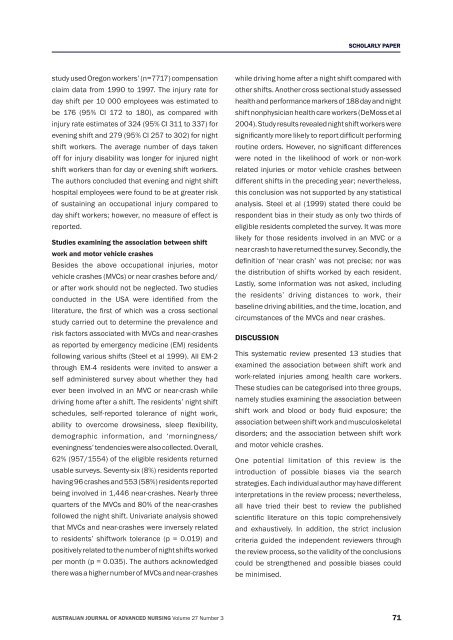March-May, 2010 - Australian Journal of Advanced Nursing
March-May, 2010 - Australian Journal of Advanced Nursing
March-May, 2010 - Australian Journal of Advanced Nursing
You also want an ePaper? Increase the reach of your titles
YUMPU automatically turns print PDFs into web optimized ePapers that Google loves.
Scholarly PAPER<br />
study used Oregon workers’ (n=7717) compensation<br />
claim data from 1990 to 1997. The injury rate for<br />
day shift per 10 000 employees was estimated to<br />
be 176 (95% CI 172 to 180), as compared with<br />
injury rate estimates <strong>of</strong> 324 (95% CI 311 to 337) for<br />
evening shift and 279 (95% CI 257 to 302) for night<br />
shift workers. The average number <strong>of</strong> days taken<br />
<strong>of</strong>f for injury disability was longer for injured night<br />
shift workers than for day or evening shift workers.<br />
The authors concluded that evening and night shift<br />
hospital employees were found to be at greater risk<br />
<strong>of</strong> sustaining an occupational injury compared to<br />
day shift workers; however, no measure <strong>of</strong> effect is<br />
reported.<br />
Studies examining the association between shift<br />
work and motor vehicle crashes<br />
Besides the above occupational injuries, motor<br />
vehicle crashes (MVCs) or near crashes before and/<br />
or after work should not be neglected. Two studies<br />
conducted in the USA were identified from the<br />
literature, the first <strong>of</strong> which was a cross sectional<br />
study carried out to determine the prevalence and<br />
risk factors associated with MVCs and near‐crashes<br />
as reported by emergency medicine (EM) residents<br />
following various shifts (Steel et al 1999). All EM‐2<br />
through EM‐4 residents were invited to answer a<br />
self administered survey about whether they had<br />
ever been involved in an MVC or near‐crash while<br />
driving home after a shift. The residents’ night shift<br />
schedules, self‐reported tolerance <strong>of</strong> night work,<br />
ability to overcome drowsiness, sleep flexibility,<br />
demographic information, and ‘morningness/<br />
eveningness’ tendencies were also collected. Overall,<br />
62% (957/1554) <strong>of</strong> the eligible residents returned<br />
usable surveys. Seventy‐six (8%) residents reported<br />
having 96 crashes and 553 (58%) residents reported<br />
being involved in 1,446 near‐crashes. Nearly three<br />
quarters <strong>of</strong> the MVCs and 80% <strong>of</strong> the near‐crashes<br />
followed the night shift. Univariate analysis showed<br />
that MVCs and near‐crashes were inversely related<br />
to residents’ shiftwork tolerance (p = 0.019) and<br />
positively related to the number <strong>of</strong> night shifts worked<br />
per month (p = 0.035). The authors acknowledged<br />
there was a higher number <strong>of</strong> MVCs and near‐crashes<br />
while driving home after a night shift compared with<br />
other shifts. Another cross sectional study assessed<br />
health and performance markers <strong>of</strong> 188 day and night<br />
shift nonphysician health care workers (DeMoss et al<br />
2004). Study results revealed night shift workers were<br />
significantly more likely to report difficult performing<br />
routine orders. However, no significant differences<br />
were noted in the likelihood <strong>of</strong> work or non‐work<br />
related injuries or motor vehicle crashes between<br />
different shifts in the preceding year; nevertheless,<br />
this conclusion was not supported by any statistical<br />
analysis. Steel et al (1999) stated there could be<br />
respondent bias in their study as only two thirds <strong>of</strong><br />
eligible residents completed the survey. It was more<br />
likely for those residents involved in an MVC or a<br />
near crash to have returned the survey. Secondly, the<br />
definition <strong>of</strong> ‘near crash’ was not precise; nor was<br />
the distribution <strong>of</strong> shifts worked by each resident.<br />
Lastly, some information was not asked, including<br />
the residents’ driving distances to work, their<br />
baseline driving abilities, and the time, location, and<br />
circumstances <strong>of</strong> the MVCs and near crashes.<br />
DISCUSSION<br />
This systematic review presented 13 studies that<br />
examined the association between shift work and<br />
work‐related injuries among health care workers.<br />
These studies can be categorised into three groups,<br />
namely studies examining the association between<br />
shift work and blood or body fluid exposure; the<br />
association between shift work and musculoskeletal<br />
disorders; and the association between shift work<br />
and motor vehicle crashes.<br />
One potential limitation <strong>of</strong> this review is the<br />
introduction <strong>of</strong> possible biases via the search<br />
strategies. Each individual author may have different<br />
interpretations in the review process; nevertheless,<br />
all have tried their best to review the published<br />
scientific literature on this topic comprehensively<br />
and exhaustively. In addition, the strict inclusion<br />
criteria guided the independent reviewers through<br />
the review process, so the validity <strong>of</strong> the conclusions<br />
could be strengthened and possible biases could<br />
be minimised.<br />
AUSTRALIAN JOURNAL OF ADVANCED NURSING Volume 27 Number 3 71

















